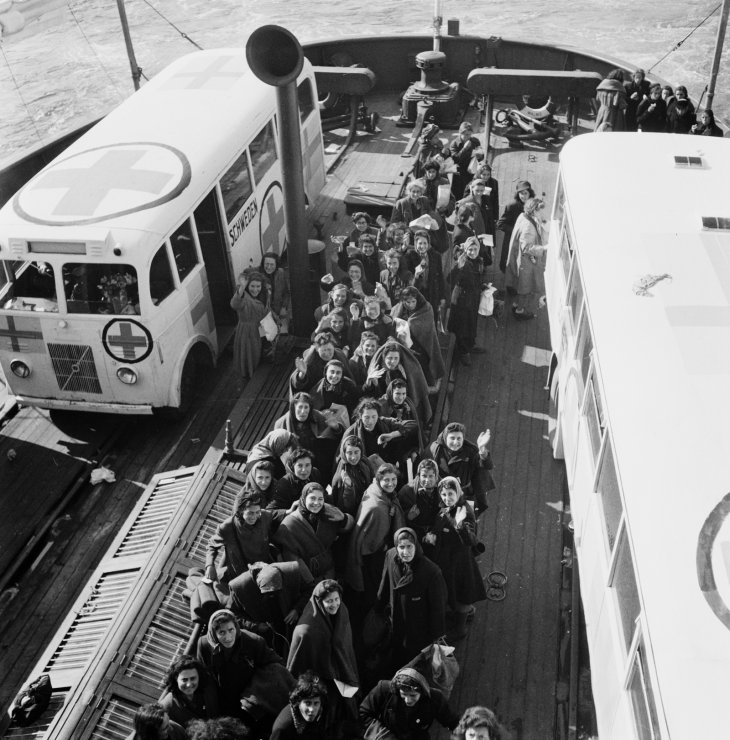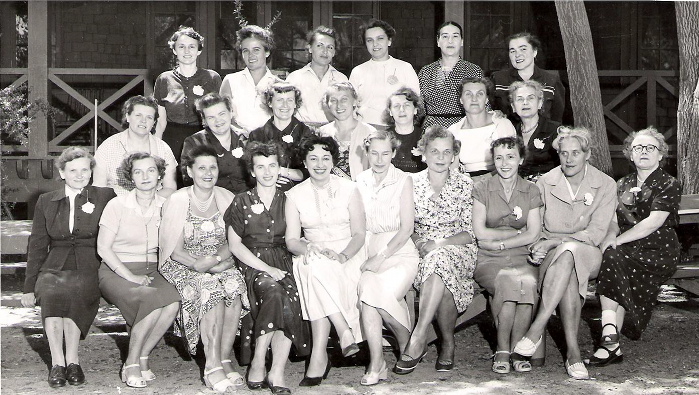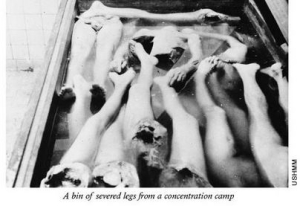 Ravensbrück was conveniently situated and its Revier (hospital) was staffed with doctors and nurses. Experimental medical atrocities were conducted under the watchful eye of chief of SS chief Heinrich Himmler who was fascinated by medical experimentation, and his approval was necessary for every deadly experiment conducted at SS concentration camps. Five miles from the camp was the Hohenlychen clinic; originally built as a sanatorium for children with tuberculosis. Beginning in 1933, it served as a clinic for sports medicine, providing therapies for athletes; later high ranking wounded soldiers were treated there. It was frequented by the luminaries of the Reich.
Ravensbrück was conveniently situated and its Revier (hospital) was staffed with doctors and nurses. Experimental medical atrocities were conducted under the watchful eye of chief of SS chief Heinrich Himmler who was fascinated by medical experimentation, and his approval was necessary for every deadly experiment conducted at SS concentration camps. Five miles from the camp was the Hohenlychen clinic; originally built as a sanatorium for children with tuberculosis. Beginning in 1933, it served as a clinic for sports medicine, providing therapies for athletes; later high ranking wounded soldiers were treated there. It was frequented by the luminaries of the Reich.

Hohenlychen director, Dr. Karl Gebhardt, was Heinrich Himmler’s personal physician; he was also Chief Surgeon of the Reich Physician SS and Police; as well as the President of the German Red Cross. Gebhardt masterminded the ghastly surgical experiments conducted at Ravensbrück from July 1942 and August 1943 on 86 young healthy young women and girls — one as young as sixteen. The women were affectionately nicknamed throughout the camp, “Króliki” “kaninchen” or “lapins” or “rabbits” because they were used as human laboratory animals.
The experiments were designed to maim and cripple healthy human beings. Their leg bones were broken, pieces of bone extracted; nerves and muscles torn. To simulate battle injuries, the doctors sought to maximize infection by deliberately infecting the wounds using increasingly more potent bacteria cultures; rubbing the surgical wounds with bacteria, sawdust, rusty nails, and slivers of glass. They found the use of gangrenous cultures resulted in the most “successful” severe infections within 24 hours.
Other radical surgical experiments were purely exploratory; to see what happens when parts of bone, nerve and muscle are cut, removed. In some experiments limbs were amputated and transplanted. The predictable results: some of the “rabbits” died; those who survived the surgeries were painfully mutilated, crippled and susceptible to infection. (Jarek Gajewski: Ravensbrück 74 Cases of Medical Experiments Conducted on Polish Political Prisoners, a website maintained at the University of Toronto)
The human “rabbits” of Ravensbrück
The seventy-four young Polish political prisoners were healthy young women and girls – the youngest was sixteen years old. There is no record identifying the twelve women of other nationalities who were subjected to the inhuman experiments. The women were selected for this gruesome assignment by the senior camp doctor, Walter Sonntag.
“The women were forcibly taken [ ] in groups of five to ten, anesthetized, and awakened with deep wounds on their legs. Some died shortly afterward; those who survived suffered serious aftereffects. It became known, almost immediately, that these “operations” had been performed by an internationally renowned surgeon, SS Professor Karl Gebhardt, director of the Hohenlychen clinic.” (Ravensbrück website, University of Toronto)
“They took those legs that so loved movement and dancing, and removed a large section of bone from them. Then, for good measure, they injected them with bacteria. She lay there, butchered, her legs in plaster – still trying to smile.” (Wanda Poltawska. And I am Afraid of My Dreams, 1961; trans. 1987)
 Sulfanilamide drug experiments
Sulfanilamide drug experiments
The first group of experiments was designed to test the efficacy of Sulfanilamide drugs using several methods designed to cause severe infections. The description of the procedures was provided by Dr. Fritz Fischer, a defendant at Nuremberg. A surgical incision on the outside of the lower leg, the wound was filled with bacteria and sewn up. In the course of experiments, progressively more virulent bacteria were used; such as streptococcus, gas gangrene, and tetanus; wood shavings and glass were added to the mix and blood circulation was interrupted by tying off blood vessels at both ends of the wound to create a condition similar to that of a battlefield.
According to several accounts the real purpose of the Sulfanilamide experiments was to vindicate Dr. Karl Gebhardt whom Hitler had suspected of contributing to the death of an SS officer by not administering sulfa drugs when treating his gunshot wounds. Gebhardt needed to demonstrate the ineffectiveness of sulfa for the treatment of battlefield wound infections. Gebhardt designed experiments which he manipulated to demonstrate that the sulfa drugs used in the military did not prevent death. In the experiments, in most instances the controls survived the experiments because they received proper medical after care whereas those who were give sulfa were callously neglected. (Wikipedia)
At the insistence of the Surgeon General of the Reich, Dr. Ernst Robert Gravitz a more radical surgical procedure was adopted; a wound was inflicted by shooting the victims prior to the surgical “treatment”– resulting in the death of all five of the women.(Jarosław Gajewski. Regained Faith in People, University of Toronto, 2011)
 Surgical experiments were designed to maim and cripple healthy human beings.
Surgical experiments were designed to maim and cripple healthy human beings.
Their legs were cut open, muscles removed, bones broken or shattered and gangrenous infectious germs rubbed into their wounds before they were sewn up. The victims suffered intense agony; those who survived were left with horrific pain, crippling mutilation and permanent disability. They are prone to various serious medical conditions from their exposure to those germs.
“The victims were very young, almost children; they were chosen from groups of high school and university students. Some who had survived the operations were executed, but there were about sixty still alive when we arrived in October 1943.” (Germaine Tillion. Ravensbrück, 1975, ch. 8 cited at Ravensbrück website, University of Toronto)
[View photographs of the 74 Polish victims of medical experimentation atrocities (also here); View the itemized chart recording the name, age, date and type of experiment each underwent.]
The inhumane macabre experimentation at Ravensbrück was planned and approved by Heinrich Himmler. The results of the experiments were presented and discussed in great detail by SS medical officers and other doctors in an organized conference in Berlin on May 24th to the 26th, 1943. The procedures and the deaths of several subjects were reviewed but their deaths were merely mentioned in passing. No one objected to the cruelty of the experiments. (Machlejd. Experimental Operations on Prisoners at Ravensbrück, 1960, p. 15)
A Polish physician – radiologist who was an inmate at Ravensbrück, and whose job was to take X-rays after each surgical procedure, provided written testimony to the Polish Documentary Institute in Lund, Sweden (in 1946):
“All of the women operated on and infected were ill for a very long time, with fevers of up to 40ºC, and with changes in their blood and urine indicating the presence of serious infections. The white blood cell (leucocyte) count reached 20,000 and 30,000 and the urine indicated serious damage to the body, principally to the liver, and the disintegration of protein.”
- Bone Operations:
. . . .The operations during which bones were broken lasted up to 3 hours, during which the shin bones of both legs were broken with hammers on the operating table, after both bones had been exposed by an operation first. Then the bones were set with the aid of clamps . . . or without clamps . . . the wounds were sewn shut and the extremities were put into plaster casts and after a few days the plaster cast was taken off and the broken extremities were left to heal without the protection of a plaster cast. Group B involved bone grafts and during group c bone operations a square bone splinter was cut into the bone . . . usually in both shins . . . and usually in two places. . . .- Muscle Operations:
During these operations, pieces of muscle were excised from the lower extremities, both from the thigh and shin. The victims were operated on several times, removing larger and larger pieces of muscle the second and third times, causing larger and larger holes and greater weakness of the extremities. . . .. . . . if they had been interested in the regeneration of bones, they would have had to be monitoring the patients for months, and even years, and here monitoring lasted weeks. All of those operations were worthless in scientific terms, because they did not fulfil the criteria for scientific experiments. . . In order to emphasize the tragedy of this crime even more, I cite Dr. Oberhäuser’s inadvertent “admission”: “there was at least one good thing about those operations: I got a bit of practice operating, and I have a chance of getting a position at Hohenlychen. . . .
3. Special types of operations “for which the world does not yet have a name”
were conducted by Dr. Gebrahdt on abnormal prisoners (i.e. Mentally ill or retarded). They were selected, regardless of nationality or category.The prisoners’ entire lower limbs were amputated by enucleation of the hip joint, as were the upper limbs, which were removed along with the shoulder blade, and then the victim, having been operated on in this way, was killed on the operating table, by [lethal] injection, inasmuch as she was still alive. (Voices from Ravensbrück, English Translation of Witness Testimonies, 1946)
In August 1943, five victims were operated in a bunker cell. The women operated on were not bathed first, but rather SS men would throw them violently onto the bunks, their mouths gagged, and their legs, dirty from coal dust. After the operations, they remained in the bunker cell for a time before being taken to the camp hospital.
Of the 74 Polish rabbits who were subjected to these surgical abominations: 5 died immediately having been infected with the most virulent strains of bacteria; 6 were executed after surgery “as their role as experimental material had ended”; and 63 miraculously survived. Given the nature of the horrific operations and the exceedingly unsanitary surroundings, all of the lapins would have been expected to die.
May 1943: German Orthopedic Society at Congress of Reich Physicians awards researchers for results of Ravensbruck mutilating experiments. (Sheldon Rubenfeld, MD, Medicine After the Holocaust: From Master Race to the Human Genome and Beyond, 2010)
Super-human will to survive; resourcefulness and acts of resistance
The survival of the lapins is a testament to their initial good health and the human spirit. These young women demonstrated super-human tenacity and exceptional willpower to survive. They nurtured each other and were shielded by other inmates when they were sought for execution. The Polish contingent in the camp set up an assistance committee; assigning a “mother” for each “rabbit” to look after her welfare; to bring bits of food; and to shield her from the SS who accelerated the pace of executions.
In February 1943, the rabbits drew up a written petition protesting against the performance of those operations on healthy people; and they went to the camp commander. The petition stated:
“We, the undersigned, Polish political prisoners, ask whether Herr Commander knew that experiments were being performed on completely healthy women in this camp- all of them political prisoners. We ask whether we were operated on as a result of sentences passed on us because, as far as we know, the international law forbids the performance of operations even on political prisoners. We, the victims, hereby registered a formal protest against the research.”
Severely punished for this rebellion; but they did not give in or give up
Not only did they have the will to survive, these young victims wanted to ensure that the atrocities were documented and smuggled to the outside world. Despite attempts to isolate the camp, a few relatively privileged prisoners managed to maintain intermittent correspondence with family. The “rabbits” smuggled news of the heinous medical experiments to the outside world.

In 1943, Bogumila Jasuik and Krysia Czyz began sending invisible messages written in urine between the lines and in the margins of the censored letters to their families to inform them about the experiments and the unspeakable suffering in the camp. Bogumila’s uncle was in the Polish Home Army; he used Army couriers to inform the Polish Government- in-exile in London and the International Red Cross.

Miraculously, in May 1944, a clandestine radio station operating from a village in Buckinghamshire, U.K. broadcast Bogumila and Czyz’s reports. However, the International Committee of the Red Cross (ICC) in Geneva which had also received the information—as it had received other news about the atrocities at the camp—did nothing to intervene. The head of the ICC was Max Huber, a personal friend of Dr. Karl Gebhardt, who was the mastermind of the heinous experiments. Huber prevented the Red Cross from investigating the brutal conditions and heinous experiments at Ravensbrück.
Sarah Helm found evidence of this in conspiracy in the files of a small museum devoted to the Polish underground, located in Northwest London. Those letters and the surviving lapins’ testimonies were used as evidence by the prosecutors at Nuremberg. (Sarah Helm. Ravensbrück, 2015)
The story of the 74 “rabbits” encapsulates the worst atrocities of Ravensbrück, but also the indomitable human spirit and determination of these young women to survive, not to be annihilated without a trace. Not only did 63 of the 74 women survive the horrific surgical bone fracturing experiments that left them crippled and in chronic pain; they managed to conceal their mutilated legs during selections for death. In 1944, when the SS sought to kill the “rabbits” to remove the evidence of the diabolical experiments, the entire camp conspired to keep them hidden.
Near end of war, frenzied killing spree to eliminate evidence of criminal atrocities
Once the war began to go badly for the Nazis, they were fearful that information about the camps was being leaked to the outside world; so they embarked on mass elimination of the living human evidence of their diabolical medical experimentation. Wanda Wojtasik-Poltawska, a devout Catholic, one of the first “rabbits” to undergo the mutilating experiments, was determined to counter her sense of helplessness by making sure the outside world was aware of what was happening. When Wanda learned that she was selected to be executed, she hid among the Polish Jewish women who arrived from Auschwitz in January-February 1945; she wrote a false tattoo number on her arm and survived. (Saidel. Jewish Women of Ravensbrück, 2004)
Poltawska, who was one of the living proofs of the horrors of Ravensbrück was determined not to accept the elimination of her existence passively. Although she had initially felt utterly powerless in having to endure the operations, the experiments awakened an uncontrollable determination to survive
“We would find it easier to die if we could be certain that news of our deaths would reach the world outside.” (Wanda Poltawska. And I am Afraid of My Dreams, 1961; trans. 1987)
Documenting and collecting evidence of the crimes
The lapins were politically savvy; they fully understood that their deformities were incontestable proof of Nazi medical atrocities only if they survived alive. But just in case, they found a way to document the atrocities; by secretly having their mutilated legs photographed with a hidden camera smuggled into the camp. The women hid the film in their barrack until the end of the war.
 On April 23, 1945, 7,500 women from the camp were liberated and transported to Sweden under Project “White Buses” under an agreement negotiated by Count Folke Bernadotte, president of the Swedish Red Cross, with Heinrich Himmler.
On April 23, 1945, 7,500 women from the camp were liberated and transported to Sweden under Project “White Buses” under an agreement negotiated by Count Folke Bernadotte, president of the Swedish Red Cross, with Heinrich Himmler.
The rabbits were specifically excluded, as they were the living proof of medical crimes. Although the rabbits stayed behind, in Barrack #32, they entrusted the secret film to French ethnologist, Germaine Tillion who developed the film for the first time in Paris. Two of the clandestine pictures showing the mutilated legs of Maria Kusmierczuk and Bogumila Babinska Jasiuk were published first in the book Experimental Operations On Prisoners Of Ravensbruck Concentration Camp (1961) by Wanda Kiedrzynska.
After the war, four Polish rabbits testified at the Nuremberg Doctors Trial: Jadwiga Dzido, Maria Kusmierrczuk, Wladyslawa Karolewska, and Maria Janna Broel-Plater. Their testimonies helped convict the three doctors: Dr. Karl Gebhardt, Dr. Herta Oberheuser, and Dr. Fritz Fischer of “crimes against humanity” and war crimes. Gebhardt was sentenced to death and was hanged on June 2, 1948. Fischer was sentenced to life in prison, but this was reduced to 15 years. It is not clear why he was released as early as 1951 and why his medical license reinstated. He made his career as a chemist for the Boehringer Ingelheim pharmaceutical company.
Herta Oberheuser was sentenced to 20 years, but she too did not serve her sentence; she was released in April 1952 whereupon she practiced as a family physician until a survivor recognized her in 1956. Her medical license was revoked in 1958. The transcripts are archived in: Nuremberg Trials Project at Harvard Law School Library which Lists the Nazi Doctors responsible for the experimental atrocities at Ravensbrück.
Seven Ravensbrück trials were held in Hamburg, Germany from 1946 to 1948.
Six medical doctors, who performed criminal medical experiments, including Walter Sonntag, were sentenced to death and executed; several nurses, wardens, including Dorothea Binz; and several kapos (inmates) were either executed or imprisoned. Hans Pflaum, camp work leader, whom prisoners called the “cattle merchant,” and Fritz Suhren escaped from the British prior to the Hamburg trials but were recaptured and sentenced to death in the 1950 French military trial at Rastatt, Germany.
Germaine Tillion published several editions of her book, Ravensbrück: an Eyewitness Account of a Women’s Concentration Camp, 1975 and was the official representative for both Ravensbrück Amicale and the Association des Deportées et Internées de la Résistance at the Hamburg Ravensbrück trials. She also attended the Rastatt trials of war criminals.
The Polish lapins of Ravensbrück were forgotten behind the Soviet Iron Curtain
After they were liberated, the surviving Polish lapins returned to Poland, which was under Soviet control where they were largely forgotten behind the Iron Curtain. Furthermore, the East German regime “monopolized and instrumentalized the history of the camp;” they selected “proletarian” heroines while excluding religious anti-Nazi groups and Western non-communist resistance groups. The East German bureaucrats attempted to set in stone the legitimacy of the East German state. So geopolitics conspired, and the lapins of korilikiwere left out of the West German compensation agreements for Nazi victims.
In 1958, under the philanthropic auspices of the Ravensbrück Lapins Project, thirty-five of the sixty-three surviving Polish victims of depraved experiments were brought to the U.S. for medical and rehabilitative treatment. Norman Cousins, then editor in chief of the widely read, Saturday Review, publicized their plight, emphasizing that the fate of Polish women who were subjected to criminal experiments at Ravensbrück “is not a glimpse into the bowels of an imaginary hell but part of our age and part of our world.”

A website created by Jarek Gajewski: Ravensbrück 74 Cases of Medical Experiments Conducted on Polish Political Prisoners is maintained at the University of Toronto.
Four Polish lapin Survivors of Ravensbrück testified at the Doctors’ Trial in Nuremberg. They are archived at: Nuremberg Trials Project at Harvard Law School Library which includes the List of Nazi doctors responsible for the experimental atrocities. (Read Ravensbruck Testimony Excerpts)
Sarah Helm who interviewed many Ravensbrück survivors relates the following:
“Wanda Wojtasik- Poltawska, one of the youngest Polish Kaninchen, told me that one of the SS doctors, Fritz Fischer, had recently contacted her asking for her forgiveness. “I told him there was nothing I could forgive him for. He would have to seek forgiveness from God.”



